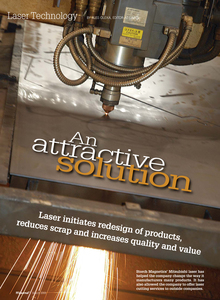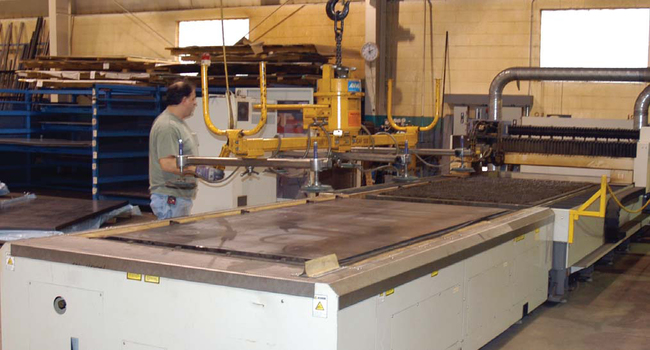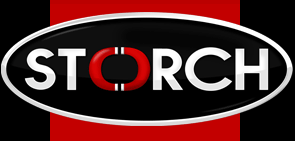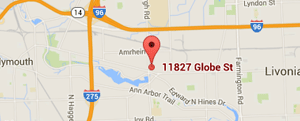
Forming & Fabricating Journal - An Attractive Solution
Laser Technology - An Attractive Solution
By Russ Olexa, Editor-at-large
Forming & Fabricating Journal
March 2008
Laser initiates redesign of products, reduces scrap and increases quality and value

Storch Magnetics’ Mitsubishi laser has helped the company change the way it manufacturers many products. It has also allowed the company to offer laser cutting services to outside companies.
Many sheet metal job shop owners would like to have a product line to even out the ups and downs of production. For Storch Magnetics, Livonia, Mich., it was just the opposite. The company had a diverse product line and introduced value-added sheet metal job shop services.
Storch Magnetics’ product lines include magnetic and nonmagnetic conveying systems and magnetic assemblies and product solutions. The company also stocks and distributes magnets. Many of these products are used for automation and material handling while others are used to separate tramp metals from powder bulk solids and other nonferrous products. With a large product catalog and new products being added yearly, the company realized that its manufacturing methods needed to be more productive. With a new piece of equipment, the company discovered a dramatic improvement in manufacturing and opened a new door as a sheet metal job shop.
Founded by Edward A. Storch in 1952 as Storch Products, the company first sold leak-detection fluids and home heating furnaces. But Storch was always on the lookout for additional products and added Bux Magnetic base drills. Customers requesting only the magnetic bases led him to look for additional sources of magnets and magnetic components and to eventually become the authorized small-quantity stock supplier for an American manufacturer of alnico and ceramic magnets. With the introduction of ceramic (ferrite) magnets, Storch gained new customers with diverse applications. Magnets quickly became the company’s mainstay product line.
Storch began engineering magnetic assemblies for varied applications, becoming the original designer and manufacturer of insulated multi-pole magnetic assemblies with magnetic fixtures, clamps, and tooling for industrial and production applications.
Later, Storch Products expanded to become Storch Magnetics, providing customers with magnetic slide conveyors, magnetic separators/filters, holding/lifting magnets, magnetic sweepers, tools and specialty designed magnetic products and systems to increase productivity, safety and profitability for clients. After Edward Storch died, his wife took over in 1960, and it remains a woman-owned business today with WBENC and ISO certification.
Todd Papora, grandson of Edward Storch and marketing and sales manager, says that the company has grown over the years through its magnetic product solutions. “The problem with magnets is that they are fragile and brittle,” he says. “Until they are laminated and protected, they will fall apart in an industrial environment, and most of the materials back in the 1960s didn’t have much strength. We didn’t have the high-energy, rare-earth magnets we have now. So we would laminate them and protect them.”

A Mitsubishi CO2 laser purchased by Storch Magnetics has opened the door for more accurately produced parts that are much easier for shop personnel to assemble downstream.
Product problems
With special products taking up to 60 percent of the company’s resources, the ability to either manufacture a completely new product or alter a stocked product was becoming a concern. Many of Storch’s standard conveyors are built to suit the exact needs of the customer, which often means altering them from standard designs. The company also makes low-volume special products, such as magnet systems that can fit in the palm of one’s hand and magnetic conveyors that are 5 ft. to 10 ft. tall and 20 ft. long. Mild steels and stainless steels are used in gauges from 11 through 20 along with mild steels in thicknesses from 1⁄16 in. to 1⁄4 in.
“Our manual labor hours for our products were just too high,” says Tom Papora, also a grandson of Edward Storch and vice president of manufacturing. “We had to find a better way of producing products.” The company’s workers were doing more craftsman-type work that required a lot of labor hours to produce a product, he notes. The company would shear, chop, punch, bend, weld and assemble a product, but often because of construction methods like drilling holes by hand, parts couldn’t be easily interchanged when damaged or worn out by the customer. Quality and scrap were also problems. Workers would take a piece of steel sheet, cut or punch out various parts and assemble the product. Then the leftover steel was often scrapped rather than saved for another job. The company wasn’t getting the best use of the metal either because parts couldn’t be dynamically nested this way. Quality wasn’t high because each part was more handcrafted than made by a precise piece of equipment, he says.
Laser to the rescue
Knowing that they had to make a change to their manufacturing processes, Tom and Todd began to look at different types of equipment such as a CNC-controlled laser or turret punch press. They reviewed equipment extensively at trade shows and compared the capabilities between the laser and turret punch press and settled on a Mitsubishi 3kW CO2 laser with a 5-ft.- by-10-ft. base.
“Mitsubishi had a great deal on this machine at a trade show,” says Tom. “For our first unit, I didn’t want to consider buying a laser that was a buy-it-and-you’re-onyour-own one. I wanted one from a wellknown company. The unit I purchased was definitely the best price for a wellknown machine that had a track record of being reliable.
“We also bought a 5-ft.-by-10-ft. pallet shuttle that allows the operator to place a sheet in the laser while he’s removing parts from the shuttle’s bed,” he says. “This keeps the laser’s uptime high. We also liked the open floorplan of the laser to allow us to get large parts in and out of the machine. We saw lasers that were limited in part access. Having small access doors would have been cumbersome for us.”
They also looked at plasma machines, but felt that the accuracy of the laser would benefit customers more in the long run. A plasma cutter, they believed, wouldn’t give them much growth or opportunity for doing precision work for other companies because it couldn’t handle the tolerances that a laser could.
Mitsubishi’s laser had an automatic focusing feature. This allowed faster cutting performance when the company changed to a different sheet metal thickness, which it often did. “This unit had the option of using four different gases,” Tom adds. “Certain gases would give us a better edge quality that customers demanded and save us a deburring operation. We use oxygen for about 90 percent of our cutting.”
The introduction of the Mitsubishi laser immediately changed the company’s manufacturing processes. “It not only cut down our labor hours per product by about 40 percent, it also simplified product assembly,” Tom says. “In the past, it took a lot of craftsmanship to build a conveyor. It was also intimidating to new hires when we had to train them when our orders increased. With lasercut parts, a new hire could now build the product much faster. All the holes would line up per the print. Previous to this, holes were often drilled during the hand assembly, which slowed the entire process, decreased overall quality and increased labor time.
“It also would take us up to three months to get people trained to build our more complex products, which wouldn’t help our lead times when orders increased,” he says. “Before we had 10-week lead times because of these problems. Now, we’ve cut that substantially.”

Storch Magnetics is known for its magnetic conveyor systems. The company’s Mitsubishi laser has helped the company make these conveyors more efficiently.
Another benefit
Along with dramatically changing the way both standard and special products were built, the laser also helped Storch Magnetics in another way. The company found that it was so efficient producing its products that the laser had open time on it. This led the company to get the word out through Storch’s Web site, a sign in front of the building and cold calling companies that might have a need for laser cutting. With this equipment, the company also became a sheet metal job shop. But along with offering laser sheet cutting, the company offered full metalforming capabilities from print to finished product.
“We offer material cutting, forming, welding, painting, deburring and assembly of integrated laser cut products,” Todd says. “Storch Magnetics has built diverse parts like ones for the automotive aftermarket for racing, such as drivelines, motor mounts and swing arms.”
“The laser has helped us broaden our product offerings,” Tom adds. “There are jobs that we wouldn’t process previously because of their complexity. They had too many angles and shapes that would have been difficult to cut. Even custom items are built in more of a production line fashion than in the past. Previously, if a person on the floor received an order for a conveyor, it was his conveyor until the day it was painted. So all the setups, switching back and forth between processes to manufacture the product, ended up being a lot of redundancy and spent motion. Now we handle different processes and steps with certain people handling each one. We aren’t tearing down and resetting each process. We’re able to run parts faster so we can do single products or parts faster or make a stockpile of parts as the orders come in. It’s improved our quality, delivery and our product repeatability. New products are also easier to build. The laser impacts the design and gives us the ability to design something with a much better finish that’s better looking. There’s really been no downside for the laser except that it was an expensive investment.
“Another reason we went with a laser over a CNC punch press is because the materials we use vary so greatly in thickness along with the types of metals,” Todd continues. “We would have different metal types and hardness to contend with that would require changing the bottom and top dies of a punch press to get the right hole size. Also, the laser leaves a burr-free part that eliminates a secondary deburring operation.”

Typical parts that Storch Magnetics cuts vary in size and design.
Eliminating scrap
Another important feature that the company uses is part nesting software for the laser. “By nesting parts, we can better use our material and dramatically cut down on scrap,” Tom says. “We really utilize the sheet well now and have gotten away from a lot of structural materials that we once used for our products that required lifting and sawing and other operations.”
At one time the company used structural steels like angle iron for conveyor legs and other components that had to be sawed, bent and welded. With sheet metal parts cut from the laser and a redesign of these parts, the company now forms them and has eliminated these structural steel parts along with processing and inventorying them, which also saves manpower, inventory costs and has improved customer delivery. Component parts are now made from sheet metal, laser-cut, formed and welded, rather than cut on a bandsaw and processed manually, for instance.
“By using laser-cut parts for our conveyor legs we’ve designed them to fit around the conveyor’s body, so two bends are done and it’s finished,” Todd says. “Also, we had three different styles of legs. Some were detachable while others were adjustable. With the laser-cut parts, we made one leg style that was detachable and adjustable to replace the other three nonvalue-added variations.
“Also, a lot of our small sheet steel parts are somewhat free components because with dynamic nesting we are now able to use areas of the sheet that we couldn’t before,” he says. “So instead of just scrapping the steel, we use it for these small parts. The more orders we’re running at one time, the better utilization of the sheet we have. Before the laser we would vary somewhere at a 24 percent to 27 percent scrap rate. Now we’re able to group two to four jobs on one sheet. It’s even forced us to change how we build products. For instance, we changed the design on our magnetic sweepers because the laser allowed us to produce it more efficiently from sheet steel rather than other steel components. Best of all, Storch customers appreciate the additional quality, value, repeatability, delivery and cost control of supplied product.”
Storch Magnetics
Livonia, Mich.
P: 734.591-2200
Fax: 734.591-2582
sales@storchmagnetics.com
www.storchmagnetics.com
Livonia, Mich.
P: 734.591-2200
Fax: 734.591-2582
sales@storchmagnetics.com
www.storchmagnetics.com
MC Machinery Systems Inc.
Wood Dale, Ill.
630/860-4210, fax: 630/ 860-4718








